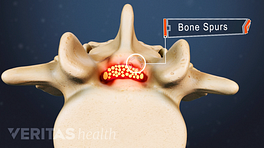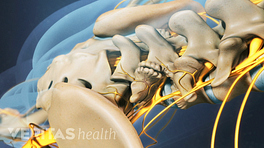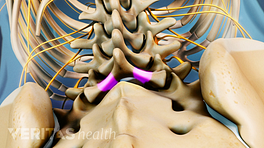A lumbar laminectomy is typically performed to alleviate pain from lumbar spinal stenosis. Spinal stenosis is caused by degenerative changes that lead to enlargement of the facet joints in the back of the vertebrae. The enlarged joints and related degenerative changes place pressure on the nerve roots as they exit the spine.
Each vertebra has two portions of vertebral bone over the nerve roots in the back of the spine. These small flat bones are called the lamina.
The lamina functions as a protective covering of the spinal canal. In the lower back, they protect the cauda equina, the nerve roots that branch off of the spinal cord, as well as the nerve roots as they exit the spine.
Removing all or part of the lamina through a lumbar laminectomy can give the affected nerve root more space and a better healing environment.
In a laminectomy surgery, the spine is approached through a 2 to 5 inch incision in the midline of the lower back.
Next the left and right back muscles, called erector spinae, are dissected off the lamina on both sides and at multiple levels.
After the spine is approached, the lamina is removed, allowing visualization of the nerve roots.
The facet joints, which are directly over the nerve roots, may then be undercut, or trimmed, to give the nerve roots more room.
After the surgeon has confirmed that all pressure has been removed from the nerve, the paraspinal muscles are sewn back together to cover the laminectomy site.
After the lamina and any other sources of pressure on the nerve roots are removed, the nerve roots have room to heal.
Articles Related to this Video:
- Lumbar Laminectomy Surgery for Spinal Stenosis (Open Decompression)
- Considerations for Lumbar Laminectomy (Open Decompression) in Treating Spinal Stenosis
- Surgical Procedure for Lumbar Laminectomy (Open Decompression) in Spinal Stenosis
- Recovery After Lumbar Laminectomy (Open Decompression) for Spinal Stenosis
- Laminectomy and Spinal Stenosis: Risks and Complications









